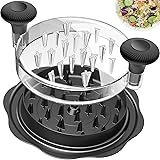Locust Firewood: Long-Lasting Heat and Why You Should Burn It

Ukeetap 10" Pro Chicken Shredder Tool Twist Large for Kitchen, BPA-Free Food-Safe Meat Grinder, Visible Chicken Breast Meat Shredder with Strong Anti-Slip Bottom & Ergonomic Handle, Black
$9.99 (as of November 11, 2025 17:35 GMT +00:00 - More infoProduct prices and availability are accurate as of the date/time indicated and are subject to change. Any price and availability information displayed on [relevant Amazon Site(s), as applicable] at the time of purchase will apply to the purchase of this product.)Electric Salt and Pepper Grinder Set - Rechargeable Automatic Salt and Pepper Shakers, Kitchen Appliances with External Adjustable Coarseness, Larger Hopper for Cooking, Home Gifts(2 Pack,Black/Black)
$23.99 (as of November 11, 2025 17:35 GMT +00:00 - More infoProduct prices and availability are accurate as of the date/time indicated and are subject to change. Any price and availability information displayed on [relevant Amazon Site(s), as applicable] at the time of purchase will apply to the purchase of this product.)BNBUN Bamboo Cutting Board for Kitchen, Wooden Cutting Board 3-Piece Set with Non-Slip Mat Deep Juice Groove and Built-In Handles, Wood Cutting Board for Meat Vegetables Fruit Ideal Gift for the Home
$29.99 (as of November 11, 2025 17:35 GMT +00:00 - More infoProduct prices and availability are accurate as of the date/time indicated and are subject to change. Any price and availability information displayed on [relevant Amazon Site(s), as applicable] at the time of purchase will apply to the purchase of this product.)Bidobibo Bear Straw Cup, Cute Baby Straw Cups Glass, Honey Bear Cup with Straws, Cute Mugs for Coffee Drinks 20oz (1 PC)
$29.99 (as of November 11, 2025 17:35 GMT +00:00 - More infoProduct prices and availability are accurate as of the date/time indicated and are subject to change. Any price and availability information displayed on [relevant Amazon Site(s), as applicable] at the time of purchase will apply to the purchase of this product.)Food Vacuum Sealer Machine, 75KPA Strong Suction, Dry/Wet Modes, 20 Vacuum Seal Bags for Food, Digital Countdown Timer, Compact Lightweight, Ideal for Home Kitchen Use
$24.99 (as of November 11, 2025 17:35 GMT +00:00 - More infoProduct prices and availability are accurate as of the date/time indicated and are subject to change. Any price and availability information displayed on [relevant Amazon Site(s), as applicable] at the time of purchase will apply to the purchase of this product.)8 Blade All-in-1 Vegetable Chopper Mandoline Slicer with Container, Food Chopper, Onion Chopper, Veggie Cutter for Salad, Kitchen Gadgets Accessories Essentials, White
$19.99 (as of November 11, 2025 17:35 GMT +00:00 - More infoProduct prices and availability are accurate as of the date/time indicated and are subject to change. Any price and availability information displayed on [relevant Amazon Site(s), as applicable] at the time of purchase will apply to the purchase of this product.)FUMMDUS Meat Thermometer Digital, 3S Instant Read Food Thermometer for Cooking with Backlight & Magnet, Foldable Temperature Probe Kitchen Gadgets Essentials for Turkey BBQ Grill Smoker Candy
$9.99 (as of November 11, 2025 17:35 GMT +00:00 - More infoProduct prices and availability are accurate as of the date/time indicated and are subject to change. Any price and availability information displayed on [relevant Amazon Site(s), as applicable] at the time of purchase will apply to the purchase of this product.)Amazon Basics Organic Cotton Waffle Kitchen Dish Towels - Ultra Absorbent, Quick Drying, Lint-Free, 15 x 25 inches, 6-Pack (4 Navy Strip/Checker, 1 White, 1 Solid Navy)
Now retrieving the price.
(as of November 11, 2025 17:35 GMT +00:00 - More infoProduct prices and availability are accurate as of the date/time indicated and are subject to change. Any price and availability information displayed on [relevant Amazon Site(s), as applicable] at the time of purchase will apply to the purchase of this product.)Warming Mat for Food Extra Large 32"x15", Electric Silicone Food Warmer Trays for Chafing Dishes & Buffet,Portable Countertop Food Warmers for Parties, 7-Level Temp 8-Hour Timer, Blue
$49.99 (as of November 11, 2025 17:35 GMT +00:00 - More infoProduct prices and availability are accurate as of the date/time indicated and are subject to change. Any price and availability information displayed on [relevant Amazon Site(s), as applicable] at the time of purchase will apply to the purchase of this product.)F-Caw-F Funny Chicken Humor F-Caw-F Quote Rooster Meme Stainless Steel Insulated Tumbler
$18.69 (as of November 11, 2025 17:35 GMT +00:00 - More infoProduct prices and availability are accurate as of the date/time indicated and are subject to change. Any price and availability information displayed on [relevant Amazon Site(s), as applicable] at the time of purchase will apply to the purchase of this product.)For those who heat their homes with wood, the quest for the perfect firewood is a perpetual endeavor. It’s a search for a wood that burns hot, lasts long, and doesn’t clog the chimney with dangerous creosote. In this pursuit, you may have come across locust trees and asked the critical question: can you burn locust wood in a fireplace? The answer is a resounding yes, and not only is it safe, but locust is also considered a premier firewood that rivals, and in some ways surpasses, the performance of famous hardwoods like oak and hickory.
Often called “yellow coal” for its incredible heat output, locust wood is a hidden gem in the firewood world. Its exceptional density and natural resistance to rot make it a superior choice for heating. However, successfully burning locust requires an understanding of its unique properties. This comprehensive guide will illuminate everything you need to know, from identifying the right type of locust tree to properly seasoning it and unlocking its full potential in your fireplace or wood stove. Prepare to discover why seasoned wood burners often choose locust over all others.
Understanding Locust Wood for Firewood
Before delving into the burning characteristics, it’s essential to know that not all locust trees are the same. The term “locust” typically refers to two primary species in North America, each with distinct qualities.
Black Locust (Robinia pseudoacacia)
Black locust is widely regarded as the champion of firewood. It’s known for its incredible density and hardness, boasting a Janka hardness rating of about 1,700 lbf, which is even higher than many species of oak . This wood is so durable and rot-resistant that it’s famously used for fence posts that can last for decades in the ground without any treatment . When it comes to firewood, these properties translate to a very high energy content, meaning it burns hotter and longer than many other common woods.
Honey Locust (Gleditsia triacanthos)
Honey locust is the other common species and is also an excellent firewood, though it is generally less dense and thornier than black locust . It burns well and produces very respectable heat. One of its notable advantages is that it is often much easier to split than black locust, making it less labor-intensive to process . While it might not quite match the supreme density of black locust, it is still a top-tier firewood that outperforms many other hardwoods.
A key feature that often makes locust available is its tendency to become “standing dead” timber. Because the wood is so resistant to decay, locust trees can die and remain standing for years, already partially seasoned and ready to be harvested for firewood without a long wait .
The Burning Qualities of Locust Firewood
So, what makes locust so highly sought after by those in the know? Its performance in the fireplace is where it truly shines. Let’s break down its burn characteristics.
Exceptional Heat Output
The most celebrated feature of locust firewood is its phenomenal heat output. Measured in British Thermal Units (BTUs), locust competes with the best in the world of firewood.
| Wood Species | Million BTUs per Cord | Key Burning Notes |
|---|---|---|
| Black Locust | 27.5 – 29.8 | Very high heat, long-lasting coals, low smoke when seasoned. |
| Honey Locust | 26.7 | High heat, easier to split than Black Locust. |
| Shagbark Hickory | 25.3 | Classic high-heat wood, can be tough to process. |
| Red Oak | 24.6 | Standard for comparison, requires long seasoning. |
| White Oak | 29.1 | One of the best all-around hardwoods. |
| Ash | 20.0+ | Reliable heat, good for easy splitting and burning. |
As the table illustrates, black locust has an incredibly high BTU, burning hotter than well-regarded woods like hickory and red oak . This means you will use less wood to achieve the same level of warmth, making your wood-gathering efforts more efficient.
Long Burn Time and Superior Coal Production
Beyond just raw heat, locust is prized for its long, steady burn. Its high density means it doesn’t consume quickly; instead, it burns slowly and deliberately. A key reason for this is its exceptional coal production. Locust forms a strong, long-lasting bed of hot coals that provides radiant heat for many hours . This makes it an ideal wood for overnight burning in a wood stove, as it can keep your fire going and your home warm until morning . Users often report coals still glowing after 8 hours or more .
Low Smoke and Minimal Creosote
A common misconception is that dense, oily woods cause creosote buildup. The opposite is true for properly seasoned locust. Because it is so dense and has a low moisture content when seasoned, it burns very hot and efficiently. This complete combustion results in minimal smoke, which in turn leads to very little creosote—a flammable, tar-like substance that is a primary cause of chimney fires . As long as the wood is properly dried, burning locust is a clean and safe option for your chimney.
Sparking and Aroma
One minor drawback to be aware of is that locust can have a tendency to pop and throw sparks as it burns . This makes it less ideal for an open, unprotected fireplace but poses little issue in a closed wood stove or a fireplace with a sturdy screen. Regarding smell, the smoke from locust has been described as having a distinctive, sometimes acrid smell, though not unpleasant . The wood itself has a slight, pleasant fragrance when burned .
How Locust Compares to Other Common Firewoods

To truly appreciate where locust fits in the firewood hierarchy, it’s helpful to compare it directly to other popular choices.
Locust vs. Oak
Oak is the gold standard for firewood, and locust is a direct competitor. Black locust has a BTU comparable to white oak and burns longer than red oak . Both require a long seasoning time, but locust has a significant advantage: rot resistance. A stack of oak left too long will begin to decay, while locust can last for decades in a woodpile without going bad . Many seasoned burners consider locust to be even better than oak due to its incredible coal production and durability.
Locust vs. Hickory
Hickory is another premium, high-BTU firewood. In direct comparisons, many wood burners express a tough choice between the two but often lean towards locust for its easier splitting and superior resistance to rot if stored long-term . Hickory can “go south pretty quick” if left on the ground, while locust remains stable .
Locust vs. Softwoods (Pine, Fir, Spruce)
This is no contest. Locust, as a dense hardwood, burns hotter, longer, and with less creosote than any softwood. Softwoods are best used as kindling, while locust is a primary heat wood.
The Challenges of Burning Locust Wood and How to Overcome Them
For all its virtues, locust does present a few challenges. However, these are easily managed with the right knowledge and approach.
The Seasoning Imperative
Like all firewood, locust must be seasoned—dried to a low moisture content—before it can be burned efficiently and safely. While some sources suggest it can be seasoned in 6-8 months, the consensus among experienced burners is that it benefits from a longer drying time, often 12 to 24 months . Burning green locust is a waste of its potential; it will be difficult to light, produce excessive smoke, and provide little heat. Proper seasoning is non-negotiable to unlock its high-BTU, low-smoke properties.
Tips for Seasoning Locust:
- Split it Early: Split logs as soon as possible after cutting to expose more surface area and speed up drying.
- Stack for Airflow: Stack wood in a sunny, well-ventilated location, raised off the ground on pallets or a rack.
- Cover the Top: Protect the stack from rain and snow with a tarp, but leave the sides open to breathe.
The Splitting Struggle
Black locust is infamous for its interlocking, stringy grain, which can make it incredibly difficult to split by hand with a maul . This is one area where honey locust has a clear advantage, as it is generally easier to split .
Tips for Splitting Black Locust:
- Use a Hydraulic Splitter: This is the most practical solution for processing a significant amount of black locust.
- Split When Frozen: The wood becomes more brittle in cold weather, making it slightly easier to split.
- Use a Sharp Axe: A razor-sharp axe or maul is more effective than a dull one.
Handling the Thorns
Both black and honey locust trees are equipped with thorns, which can be formidable, especially on honey locust . When harvesting, wear heavy-duty gloves, long sleeves, and eye protection to protect yourself from injury.
A Step-by-Step Guide to Processing and Burning Locust
If you have decided to take on the challenge of burning locust, following a disciplined process is key to success.
Step 1: Harvesting and Identification
Correctly identify the tree as either black or honey locust. The best time to cut is between late winter and early spring when the sap content is lowest . Standing dead locust is ideal, as it is already partially seasoned.
Step 2: Processing and Splitting
Once the tree is down, buck it (cut it) into manageable lengths for your fireplace, typically 14 to 18 inches. Split it immediately, while it is greenest, to make the job easier and to begin the seasoning process.
Step 3: Stacking and Seasoning
Stack your split wood in a location that gets plenty of sun and wind. It is crucial to keep the wood off the ground by using pallets or a dedicated firewood rack. Stack the wood loosely to allow maximum airflow between the pieces. Cover the top of the stack with a tarp to protect it from rain and snow, but leave the sides open to breathe. Be patient. Plan for at least one full year, and expect to need two for optimal burning.
Step 4: Testing for Dryness
Before burning, test your wood. Well-seasoned locust will be noticeably lighter than green wood. Knock two pieces together; they should make a hollow “clunk” rather than a dull “thud.” The most reliable method is to use a moisture meter. Split a piece and test the moisture content in the center of the split; it should be at or below 20%.
Step 5: Building and Maintaining the Fire
Because locust can be slow to start and doesn’t always produce a roaring flame, it is best used in a mixed fire.
- Start your fire with a softwood kindling like pine or cedar to get a strong base of heat.
- Add a few pieces of a fast-burning hardwood like ash or birch to build up a solid bed of coals.
- Once the fire is hot, add one or two pieces of well-seasoned locust. The locust will catch and burn slowly, releasing steady heat and building up excellent coals for a long-lasting fire.
The Pros and Cons of Burning Locust Wood
To help you make a final decision, here is a clear summary of the advantages and disadvantages of using locust as firewood.
Advantages:
- Exceptional Heat Output: One of the highest BTU ratings among North American woods .
- Long Burn Time: Its density allows it to burn slowly and steadily through the night.
- Excellent Coals: Produces a hot, long-lasting coal bed, perfect for sustained heating .
- Low Smoke and Creosote: When properly seasoned, it burns cleanly and safely .
- Extreme Rot Resistance: Can be stored for many years without deteriorating, a huge advantage over oak or hickory .
- Sustainable and Fast-Growing: Black locust trees grow quickly and are a renewable resource .
Disadvantages:
- Difficult to Split: Black locust is notoriously challenging to split by hand .
- Long Seasoning Time: Requires 1-2 years to dry properly for optimal performance.
- Can Produce Sparks: Not the best for open fireplaces due to popping .
- Thorns: The trees can be dangerous to harvest without proper protective gear .
Safety and Best Practices for Burning Locust
Safety should always be the top priority when using any wood-burning appliance.
- Never Burn Green Locust: This wastes its potential and creates excessive smoke and creosote.
- Annual Chimney Inspection: Have your chimney inspected and cleaned annually by a certified professional, even when burning clean wood like locust.
- Use a Spark Arrestor: Given its tendency to pop, a chimney cap with a spark arrestor is a wise precaution.
- Store Firewood Safely: Keep your woodpile away from your house to avoid attracting pests.
The Final Verdict: Can You Burn Locust Wood in a Fireplace?
So, can you burn locust wood in a fireplace? The evidence leads to a clear and definitive yes. Locust is not just an acceptable firewood; it is a premier, top-tier choice that provides some of the hottest, longest-lasting heat available. Its high BTU output, incredible coal production, and clean-burning properties when seasoned make it a favorite among experienced wood burners.
While its challenging splitting and long seasoning time require some extra effort and planning, the payoff is immense. A stack of well-seasoned locust is like gold in the woodpile, ensuring warmth and comfort even on the coldest nights. If you have access to this incredible wood, take the time to process and season it correctly. Your fireplace and your comfort will thank you.




















